Accepted Scientific Name: Copiapoa hypogaea F.Ritter
Cactus (Paris) xv. No. 66, 19 (1960).
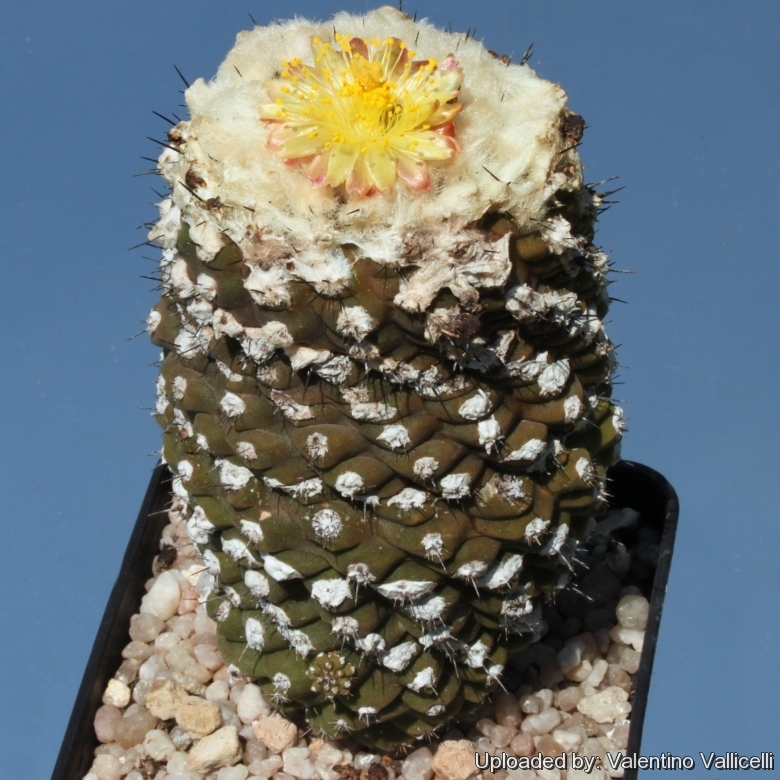
Copiapoa hypogaea var. barquitensis Photo by: Valentino Vallicelli
Origin and Habitat: Two forms of Copiapoa hypogea are known from the neighbours of Chañaral (Coastal Chile, 02 Antofagasta), the fist (rare) at north of the town shows a rugose epidermid (the so called Lizard Skin), the second near the town and in the south area with smooth epidermis (also known asCopiapoa barquitensis this second form is more familiar in the collections.
Synonyms:
See all synonyms of Copiapoa hypogaea
Description: Solitary or clumping slowly (occasionally dichotomously branched) by offsets at the base.
Root: Tuberous-napiform, connected though a narrow region to the main stem.
Stem: Grey-brown or more commonly bronzed, depressed-globose, 3-4 cm in diameter (up to 7 cm in cultivation), the aerial part is almost disc-shaped and almost sunken in the ground with white wool in the centre, also in the older areoles. Epidermis smooth.
Ribs: 10-14(16) divided in extremely low often spiralled tubercles up to 4-8 mm apart, about 4-7 mm in diameter and up to 5 mm tall.
Areoles: Small 1-3 mm wide, sunken, oval, with white felt and well separated.
Spines: Completely absent on older part of the plant.
Central spines: Absent or solitary and minute.
Radial spines: Very few (from 0 to 10) thin, short and less than 4 mm long. Brownish or black becoming ash grey and later deciduous.
Flowers: Diurnal, apical, with the typical Copiapoa scented, yellow and pink broad 1,5-2 cm long and 30-40 mm wide.
Blooming season: Hotter days in summer, blooms open about to hours after sunrise and close two hours before sunset.
Fruits: Slightly fleshy, small globular whitish with only few minuscule apical scales.
Seeds: Shining black an smooth, about 1 mm long, 0,75 mm large and 0,5 mm thick.
Subspecies, varieties, forms and cultivars of plants belonging to the Copiapoa hypogea group
Bibliography: Major references and further lectures
1) Edward Anderson “The Cactus family” Timber Press, Incorporated, 2001
2) James Cullen, Sabina G. Knees, H. Suzanne Cubey "The European Garden Flora Flowering Plants: A Manual for the Identification of Plants Cultivated in Europe, Both Out-of-Doors and Under Glass" Cambridge University Press, 11/Aug/2011
3) David R Hunt; Nigel P Taylor; Graham Charles; International Cactaceae Systematics Group. "The New Cactus Lexicon" dh books, 2006Jackie M. Poole, William R. Carr, Dana M. Price, Jason R. Singhurst “Rare plants of Texas: a field guide” Texas A&M University Press, 30/Dec/2007
4) Nathaniel Lord Britton, Joseph Nelson Rose “Cactaceae: Descriptions and Illustrations of Plants of the Cactus Family” Courier Dover Publications, 1963
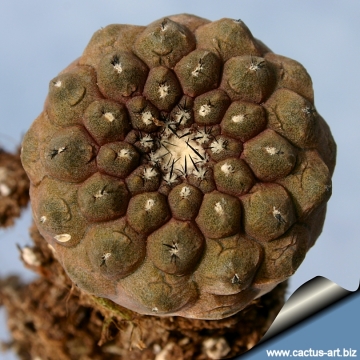 Copiapoa hypogaea var. barquitensis Photo by: Cactus Art
Copiapoa hypogaea var. barquitensis Photo by: Cactus Art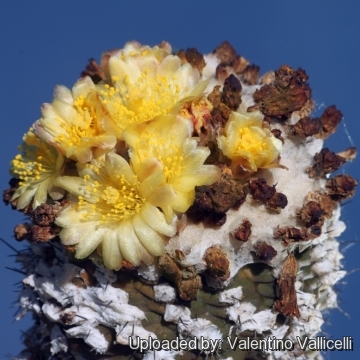 Copiapoa hypogaea var. barquitensis Photo by: Valentino Vallicelli
Copiapoa hypogaea var. barquitensis Photo by: Valentino Vallicelli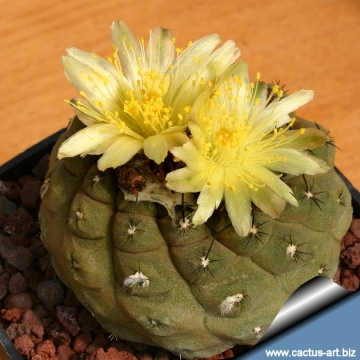 FR261 - 5km North of Chañaral, Antofagasta, Chile Photo by: Cactus Art
FR261 - 5km North of Chañaral, Antofagasta, Chile Photo by: Cactus Art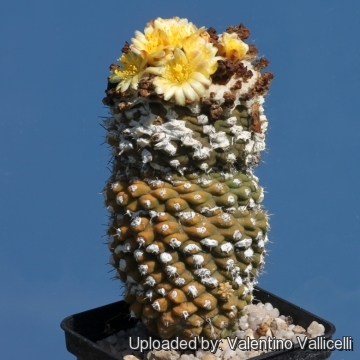 Copiapoa hypogaea var. barquitensis Photo by: Valentino Vallicelli
Copiapoa hypogaea var. barquitensis Photo by: Valentino Vallicelli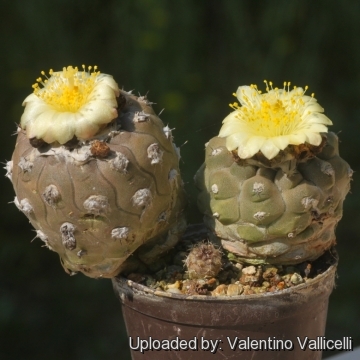 Copiapoa hypogaea var. barquitensis Photo by: Valentino Vallicelli
Copiapoa hypogaea var. barquitensis Photo by: Valentino Vallicelli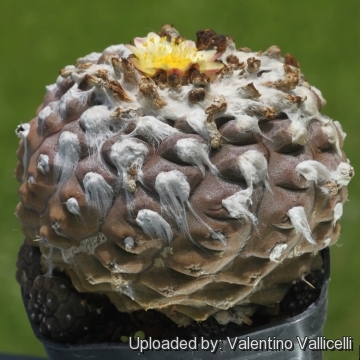 Copiapoa hypogaea var. barquitensis Photo by: Valentino Vallicelli
Copiapoa hypogaea var. barquitensis Photo by: Valentino Vallicelli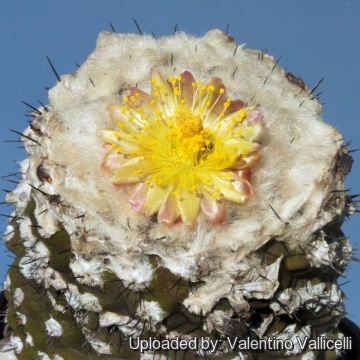 Copiapoa hypogaea var. barquitensis Photo by: Valentino Vallicelli
Copiapoa hypogaea var. barquitensis Photo by: Valentino VallicelliSend a photo of this plant.The gallery now contains thousands of pictures, however it is possible to do even more. We are, of course, seeking photos of species not yet shown in the gallery but not only that, we are also looking for better pictures than those already present.
Read More... Cultivation and Propagation: It is a summer-growing species fairly easy and robust to cultivate, but very slow growing. This plant is xerophytic, adapted to dry soils and is quite susceptible to over-watering if kept in a non ventilated place especially after the first flowering.
Growth rate: Slow-growing.
Soil: Grow it in an open mineral, sandy-gritty cactus compost and provide a very good drainage.
Exposure: It is suited for sunny-brightly exposure, but can tolerate light shade. However it will do its best only with lots of sun and become stressed with inadequate light which could result in poor growth and unnatural shape. It has a good heat tolerance.
Watering: Waterings should be rather infrequent to keep the plant compact, and avoid its becoming excessively elongated and unnatural in appearance. Furthermore it has a tap root, and watering it properly is often difficult, because it tends to crack open or rot if over-watered. Keep dry in winter or when night temperatures remain below 10° C. Mature individuals easily rot and die especially after transplanting so be extremely cautious with watering. Water it less than average if in bigger pots.
Fertilization: Feed them once during the growing season with a fertilizer specifically formulated for cactus and succulents (high potash fertilizer with a dilute low nitrogen), including all micro nutrients and trace elements diluted to ½ the strength recommended on the label. They thrive in poor soils and need a limited supplies of fertilizer to avoid the plants developing excess vegetation, which is easily attacked by fungal diseases.
Special need: It is suited for airy exposures. Provide very good ventilation. Nearly all problems occur as a result of overwatering and poor ventilation, especially when weather conditions are dull and cool or very humid. They must have very dry atmosphere.
Hardiness: It likes warmth (recommended minimum winter temperature 5° C) But plants kept perfectly dry can easily survive a light frost.
Pests & diseases: These cacti may be attractive to a variety of insects, but plants in good condition should be nearly pest-free, particularly if they are grown in a mineral potting-mix, with good exposure and ventilation. Nonetheless, there are several pests to watch for:
- Red spiders: Red spiders may be effectively rubbed up by misting the plants from above.
- Mealy bugs: Mealy bugs occasionally develop aerial into the new leaves and flowers with disfiguring results, but the worst types develop underground on the roots and are invisible except by their effects.
- Scales, thrips and aphids: These insects are rarely a problem.
- Rot: Rot is only a minor problem if the plants are watered and “aired” correctly. If they are not, fungicides won't help all that much.
Reproduction: From seed, plantlets, or grafted. The seeds can be sown in pots of fine, well-drained sandy soil, any time during the spring when temperatures are warm. Cover the seeds with a fine layer of grit and water from below with a fungicide to prevent damping off. For the 1-2 weeks cover the pots with a sheet of glass/clear perspex to keep the humidity levels high. Remove the glass and replace it with light shade-cloth and mist once or twice a day for the next two weeks after which most seeds should have germinated. From then on mistings can be reduced to every second and then every third day as the little plants grow. The seedlings should not be disturbed until they are well rooted after which they can be planted separately in small pots. Sometimes it is grafted to avoid root rot problems as plants grafted on an hardy stock are easy to grow and no special skill is required.

















